Comprehensive Asthma Case Study: Nursing and Pulmonology Approach
VerifiedAdded on 2023/06/05
|8
|2393
|475
Case Study
AI Summary
This case study examines the management of asthma in a 39-year-old athlete presenting with breathlessness, utilizing the ICF model to address impairments, activity limitations, and participation restrictions. It emphasizes the crucial role of nurses in assessing the patient's condition, providing education on self-management, and fostering therapeutic relationships. The case study also explores the involvement of a pulmonologist in managing inflammation and airway obstruction through medication and other treatments. Key aspects of nursing professionalism, such as active listening, cooperation, and keen observation, are highlighted as essential for effective patient care. Furthermore, the importance of a person-centered approach, focusing on patient autonomy and involvement in decision-making, is underscored to improve treatment outcomes and enhance the patient's quality of life. The risks associated with interventions, like social isolation and depression, are discussed along with strategies for prevention, such as therapeutic communication and encouragement.

Running Head: ASTHMA RELATED ISSUES
0
Asthma related issues
STUDENT NAME
[Pick the date]
0
Asthma related issues
STUDENT NAME
[Pick the date]
Paraphrase This Document
Need a fresh take? Get an instant paraphrase of this document with our AI Paraphraser
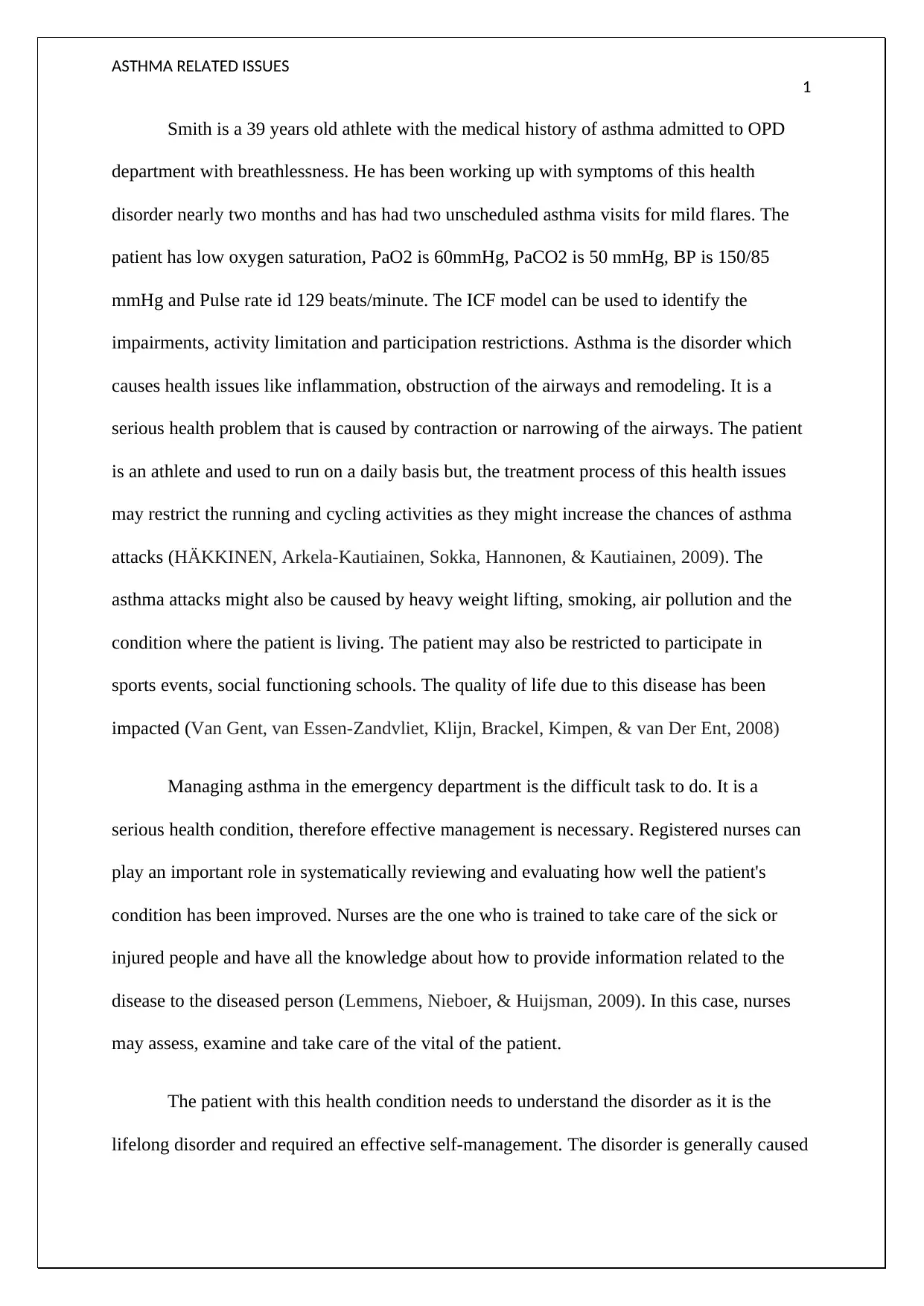
ASTHMA RELATED ISSUES
1
Smith is a 39 years old athlete with the medical history of asthma admitted to OPD
department with breathlessness. He has been working up with symptoms of this health
disorder nearly two months and has had two unscheduled asthma visits for mild flares. The
patient has low oxygen saturation, PaO2 is 60mmHg, PaCO2 is 50 mmHg, BP is 150/85
mmHg and Pulse rate id 129 beats/minute. The ICF model can be used to identify the
impairments, activity limitation and participation restrictions. Asthma is the disorder which
causes health issues like inflammation, obstruction of the airways and remodeling. It is a
serious health problem that is caused by contraction or narrowing of the airways. The patient
is an athlete and used to run on a daily basis but, the treatment process of this health issues
may restrict the running and cycling activities as they might increase the chances of asthma
attacks (HÄKKINEN, Arkela-Kautiainen, Sokka, Hannonen, & Kautiainen, 2009). The
asthma attacks might also be caused by heavy weight lifting, smoking, air pollution and the
condition where the patient is living. The patient may also be restricted to participate in
sports events, social functioning schools. The quality of life due to this disease has been
impacted (Van Gent, van Essen-Zandvliet, Klijn, Brackel, Kimpen, & van Der Ent, 2008)
Managing asthma in the emergency department is the difficult task to do. It is a
serious health condition, therefore effective management is necessary. Registered nurses can
play an important role in systematically reviewing and evaluating how well the patient's
condition has been improved. Nurses are the one who is trained to take care of the sick or
injured people and have all the knowledge about how to provide information related to the
disease to the diseased person (Lemmens, Nieboer, & Huijsman, 2009). In this case, nurses
may assess, examine and take care of the vital of the patient.
The patient with this health condition needs to understand the disorder as it is the
lifelong disorder and required an effective self-management. The disorder is generally caused
1
Smith is a 39 years old athlete with the medical history of asthma admitted to OPD
department with breathlessness. He has been working up with symptoms of this health
disorder nearly two months and has had two unscheduled asthma visits for mild flares. The
patient has low oxygen saturation, PaO2 is 60mmHg, PaCO2 is 50 mmHg, BP is 150/85
mmHg and Pulse rate id 129 beats/minute. The ICF model can be used to identify the
impairments, activity limitation and participation restrictions. Asthma is the disorder which
causes health issues like inflammation, obstruction of the airways and remodeling. It is a
serious health problem that is caused by contraction or narrowing of the airways. The patient
is an athlete and used to run on a daily basis but, the treatment process of this health issues
may restrict the running and cycling activities as they might increase the chances of asthma
attacks (HÄKKINEN, Arkela-Kautiainen, Sokka, Hannonen, & Kautiainen, 2009). The
asthma attacks might also be caused by heavy weight lifting, smoking, air pollution and the
condition where the patient is living. The patient may also be restricted to participate in
sports events, social functioning schools. The quality of life due to this disease has been
impacted (Van Gent, van Essen-Zandvliet, Klijn, Brackel, Kimpen, & van Der Ent, 2008)
Managing asthma in the emergency department is the difficult task to do. It is a
serious health condition, therefore effective management is necessary. Registered nurses can
play an important role in systematically reviewing and evaluating how well the patient's
condition has been improved. Nurses are the one who is trained to take care of the sick or
injured people and have all the knowledge about how to provide information related to the
disease to the diseased person (Lemmens, Nieboer, & Huijsman, 2009). In this case, nurses
may assess, examine and take care of the vital of the patient.
The patient with this health condition needs to understand the disorder as it is the
lifelong disorder and required an effective self-management. The disorder is generally caused
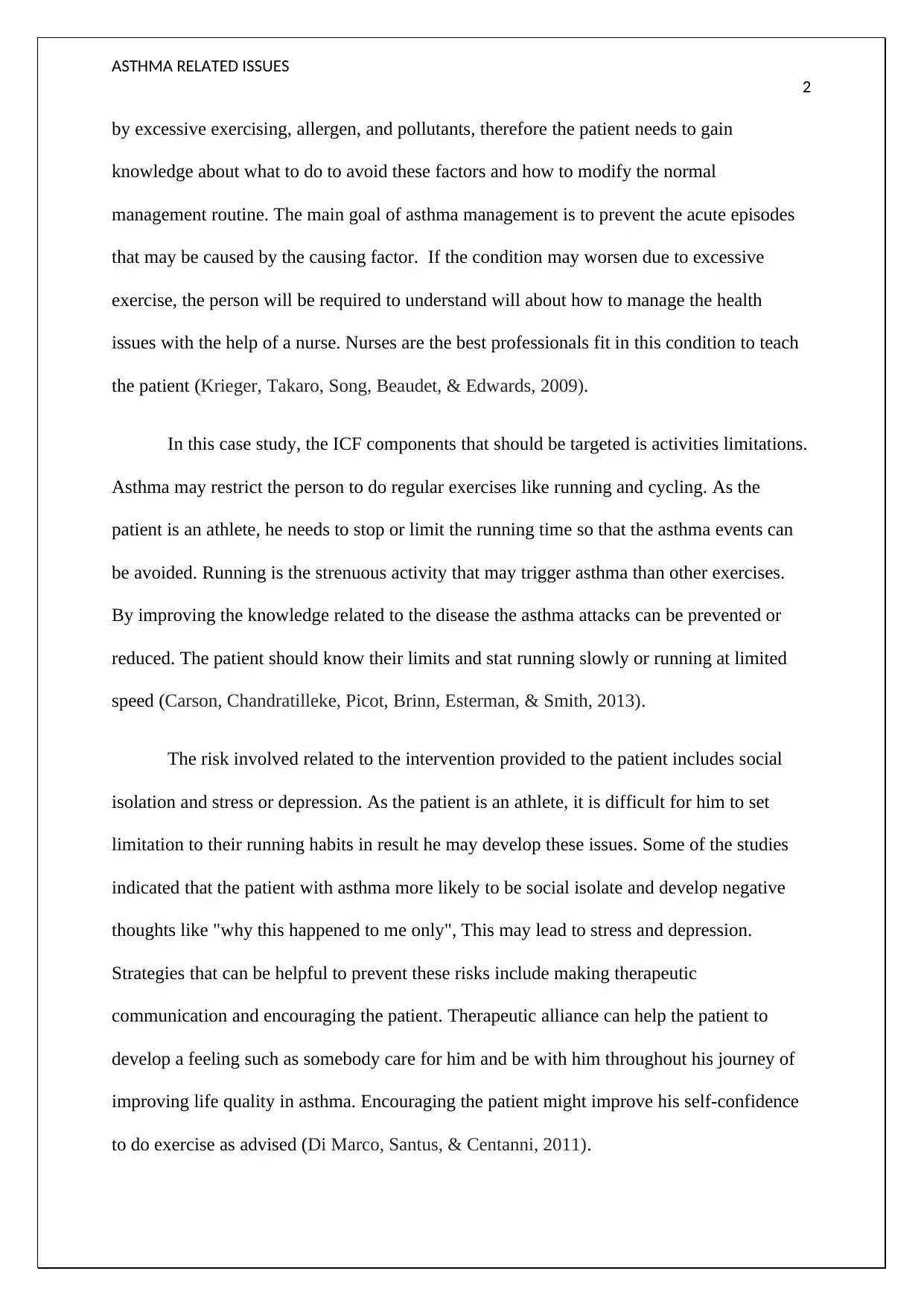
ASTHMA RELATED ISSUES
2
by excessive exercising, allergen, and pollutants, therefore the patient needs to gain
knowledge about what to do to avoid these factors and how to modify the normal
management routine. The main goal of asthma management is to prevent the acute episodes
that may be caused by the causing factor. If the condition may worsen due to excessive
exercise, the person will be required to understand will about how to manage the health
issues with the help of a nurse. Nurses are the best professionals fit in this condition to teach
the patient (Krieger, Takaro, Song, Beaudet, & Edwards, 2009).
In this case study, the ICF components that should be targeted is activities limitations.
Asthma may restrict the person to do regular exercises like running and cycling. As the
patient is an athlete, he needs to stop or limit the running time so that the asthma events can
be avoided. Running is the strenuous activity that may trigger asthma than other exercises.
By improving the knowledge related to the disease the asthma attacks can be prevented or
reduced. The patient should know their limits and stat running slowly or running at limited
speed (Carson, Chandratilleke, Picot, Brinn, Esterman, & Smith, 2013).
The risk involved related to the intervention provided to the patient includes social
isolation and stress or depression. As the patient is an athlete, it is difficult for him to set
limitation to their running habits in result he may develop these issues. Some of the studies
indicated that the patient with asthma more likely to be social isolate and develop negative
thoughts like "why this happened to me only", This may lead to stress and depression.
Strategies that can be helpful to prevent these risks include making therapeutic
communication and encouraging the patient. Therapeutic alliance can help the patient to
develop a feeling such as somebody care for him and be with him throughout his journey of
improving life quality in asthma. Encouraging the patient might improve his self-confidence
to do exercise as advised (Di Marco, Santus, & Centanni, 2011).
2
by excessive exercising, allergen, and pollutants, therefore the patient needs to gain
knowledge about what to do to avoid these factors and how to modify the normal
management routine. The main goal of asthma management is to prevent the acute episodes
that may be caused by the causing factor. If the condition may worsen due to excessive
exercise, the person will be required to understand will about how to manage the health
issues with the help of a nurse. Nurses are the best professionals fit in this condition to teach
the patient (Krieger, Takaro, Song, Beaudet, & Edwards, 2009).
In this case study, the ICF components that should be targeted is activities limitations.
Asthma may restrict the person to do regular exercises like running and cycling. As the
patient is an athlete, he needs to stop or limit the running time so that the asthma events can
be avoided. Running is the strenuous activity that may trigger asthma than other exercises.
By improving the knowledge related to the disease the asthma attacks can be prevented or
reduced. The patient should know their limits and stat running slowly or running at limited
speed (Carson, Chandratilleke, Picot, Brinn, Esterman, & Smith, 2013).
The risk involved related to the intervention provided to the patient includes social
isolation and stress or depression. As the patient is an athlete, it is difficult for him to set
limitation to their running habits in result he may develop these issues. Some of the studies
indicated that the patient with asthma more likely to be social isolate and develop negative
thoughts like "why this happened to me only", This may lead to stress and depression.
Strategies that can be helpful to prevent these risks include making therapeutic
communication and encouraging the patient. Therapeutic alliance can help the patient to
develop a feeling such as somebody care for him and be with him throughout his journey of
improving life quality in asthma. Encouraging the patient might improve his self-confidence
to do exercise as advised (Di Marco, Santus, & Centanni, 2011).
⊘ This is a preview!⊘
Do you want full access?
Subscribe today to unlock all pages.

Trusted by 1+ million students worldwide

ASTHMA RELATED ISSUES
3
The other health professional in the inter-professional team assigned for Mr. Smith is
pulmonologist. A pulmonologist is the expert doctor that specializes particularly in lung
issues and respiratory disorders like the disease of the respiratory system including upper
airways, lungs, the thoracic chest wall, and thoracic cavity. This may also include the other
parts of the body that affects the ling functioning. A pulmonologist is classified under
internal medicine subspecialty. They are the one who is able to perform a complete
pulmonary (lung) function testing. The patients should see a pulmonologist they are unable to
achieve a good asthma control with the help of the primary care doctors. People should meet
to a pulmonologist if they experience a life threating asthma attacks, hospitalized and
controlled after 3 to 6 months, respiratory symptoms besides asthma. In addition to a
deceased person's physical examination and interviews the pulmonary expert mat also person
different complex tests to diagnosed the patient condition. The flexible scopes can be used by
them to look at and biopsy the air passage. The individual in the case study have issues like
breathlessness and other respirations that are caused due to airways obstruction. A
pulmonologist may help him to manage this particular airways problem (Bass, P. (2018).
The components of ICF can that can be targeted by the pulmonologist include
inflammation and airway obstructions. They are specialized in internal medication to treat
the health issues. A pulmonologist may prescribe some medicine to manage asthma such as
beta 2 antagonists, corticosteroids, nedocromil sodium, anticholinergic medications, and
methylxanthines. He or she can also apply immunological treatment. Epinephrine can also be
prescribed to treat airway swelling caused by allergens (Dale et al., 2017).
The characteristics of nursing professionalism that every nurse should have included
being confident to take the decision in client care, humble & honest, fulfill duties, self-
confident, honest towards the client, loyalty for their duty, co-operative, good listener, the
3
The other health professional in the inter-professional team assigned for Mr. Smith is
pulmonologist. A pulmonologist is the expert doctor that specializes particularly in lung
issues and respiratory disorders like the disease of the respiratory system including upper
airways, lungs, the thoracic chest wall, and thoracic cavity. This may also include the other
parts of the body that affects the ling functioning. A pulmonologist is classified under
internal medicine subspecialty. They are the one who is able to perform a complete
pulmonary (lung) function testing. The patients should see a pulmonologist they are unable to
achieve a good asthma control with the help of the primary care doctors. People should meet
to a pulmonologist if they experience a life threating asthma attacks, hospitalized and
controlled after 3 to 6 months, respiratory symptoms besides asthma. In addition to a
deceased person's physical examination and interviews the pulmonary expert mat also person
different complex tests to diagnosed the patient condition. The flexible scopes can be used by
them to look at and biopsy the air passage. The individual in the case study have issues like
breathlessness and other respirations that are caused due to airways obstruction. A
pulmonologist may help him to manage this particular airways problem (Bass, P. (2018).
The components of ICF can that can be targeted by the pulmonologist include
inflammation and airway obstructions. They are specialized in internal medication to treat
the health issues. A pulmonologist may prescribe some medicine to manage asthma such as
beta 2 antagonists, corticosteroids, nedocromil sodium, anticholinergic medications, and
methylxanthines. He or she can also apply immunological treatment. Epinephrine can also be
prescribed to treat airway swelling caused by allergens (Dale et al., 2017).
The characteristics of nursing professionalism that every nurse should have included
being confident to take the decision in client care, humble & honest, fulfill duties, self-
confident, honest towards the client, loyalty for their duty, co-operative, good listener, the
Paraphrase This Document
Need a fresh take? Get an instant paraphrase of this document with our AI Paraphraser
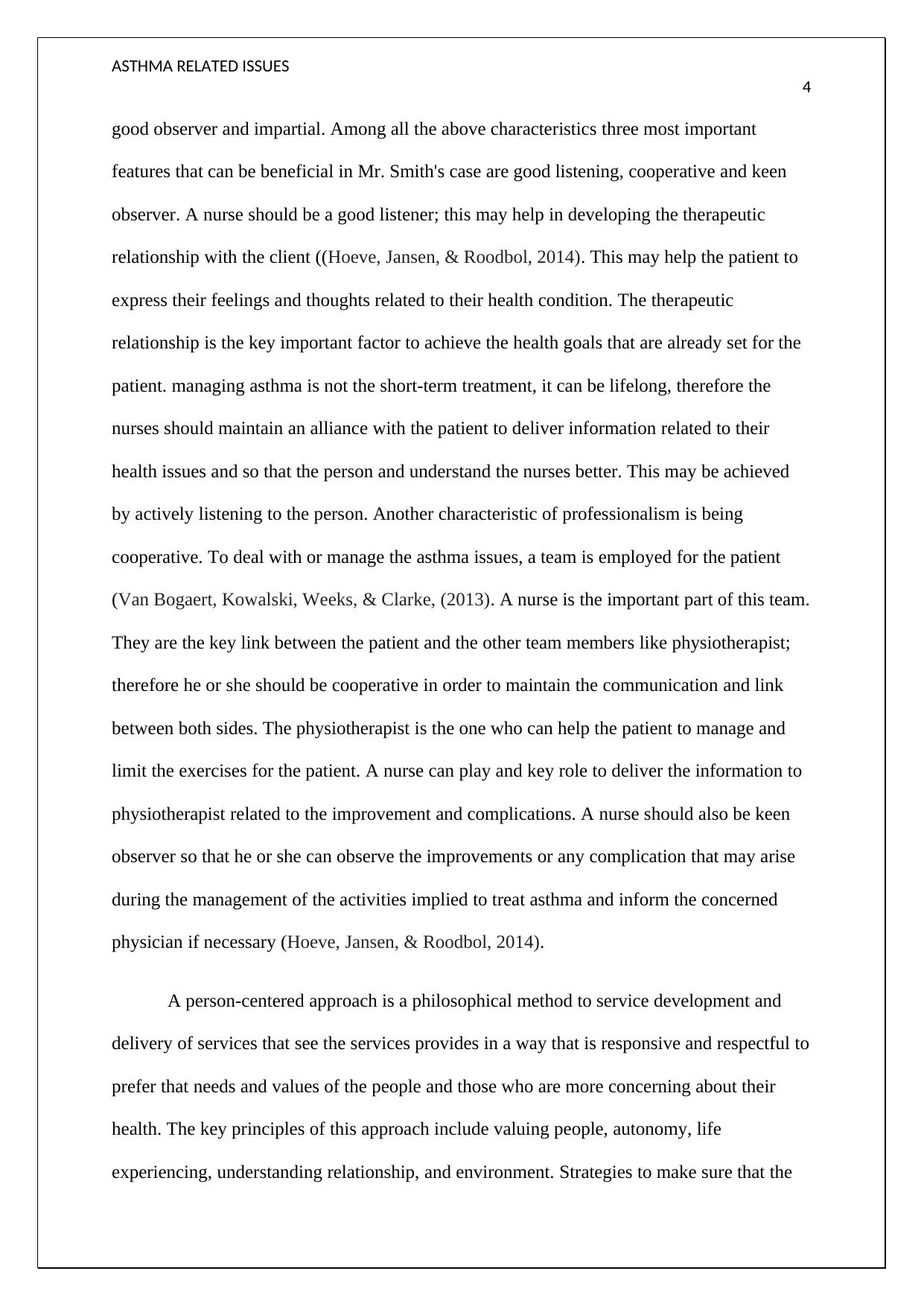
ASTHMA RELATED ISSUES
4
good observer and impartial. Among all the above characteristics three most important
features that can be beneficial in Mr. Smith's case are good listening, cooperative and keen
observer. A nurse should be a good listener; this may help in developing the therapeutic
relationship with the client ((Hoeve, Jansen, & Roodbol, 2014). This may help the patient to
express their feelings and thoughts related to their health condition. The therapeutic
relationship is the key important factor to achieve the health goals that are already set for the
patient. managing asthma is not the short-term treatment, it can be lifelong, therefore the
nurses should maintain an alliance with the patient to deliver information related to their
health issues and so that the person and understand the nurses better. This may be achieved
by actively listening to the person. Another characteristic of professionalism is being
cooperative. To deal with or manage the asthma issues, a team is employed for the patient
(Van Bogaert, Kowalski, Weeks, & Clarke, (2013). A nurse is the important part of this team.
They are the key link between the patient and the other team members like physiotherapist;
therefore he or she should be cooperative in order to maintain the communication and link
between both sides. The physiotherapist is the one who can help the patient to manage and
limit the exercises for the patient. A nurse can play and key role to deliver the information to
physiotherapist related to the improvement and complications. A nurse should also be keen
observer so that he or she can observe the improvements or any complication that may arise
during the management of the activities implied to treat asthma and inform the concerned
physician if necessary (Hoeve, Jansen, & Roodbol, 2014).
A person-centered approach is a philosophical method to service development and
delivery of services that see the services provides in a way that is responsive and respectful to
prefer that needs and values of the people and those who are more concerning about their
health. The key principles of this approach include valuing people, autonomy, life
experiencing, understanding relationship, and environment. Strategies to make sure that the
4
good observer and impartial. Among all the above characteristics three most important
features that can be beneficial in Mr. Smith's case are good listening, cooperative and keen
observer. A nurse should be a good listener; this may help in developing the therapeutic
relationship with the client ((Hoeve, Jansen, & Roodbol, 2014). This may help the patient to
express their feelings and thoughts related to their health condition. The therapeutic
relationship is the key important factor to achieve the health goals that are already set for the
patient. managing asthma is not the short-term treatment, it can be lifelong, therefore the
nurses should maintain an alliance with the patient to deliver information related to their
health issues and so that the person and understand the nurses better. This may be achieved
by actively listening to the person. Another characteristic of professionalism is being
cooperative. To deal with or manage the asthma issues, a team is employed for the patient
(Van Bogaert, Kowalski, Weeks, & Clarke, (2013). A nurse is the important part of this team.
They are the key link between the patient and the other team members like physiotherapist;
therefore he or she should be cooperative in order to maintain the communication and link
between both sides. The physiotherapist is the one who can help the patient to manage and
limit the exercises for the patient. A nurse can play and key role to deliver the information to
physiotherapist related to the improvement and complications. A nurse should also be keen
observer so that he or she can observe the improvements or any complication that may arise
during the management of the activities implied to treat asthma and inform the concerned
physician if necessary (Hoeve, Jansen, & Roodbol, 2014).
A person-centered approach is a philosophical method to service development and
delivery of services that see the services provides in a way that is responsive and respectful to
prefer that needs and values of the people and those who are more concerning about their
health. The key principles of this approach include valuing people, autonomy, life
experiencing, understanding relationship, and environment. Strategies to make sure that the
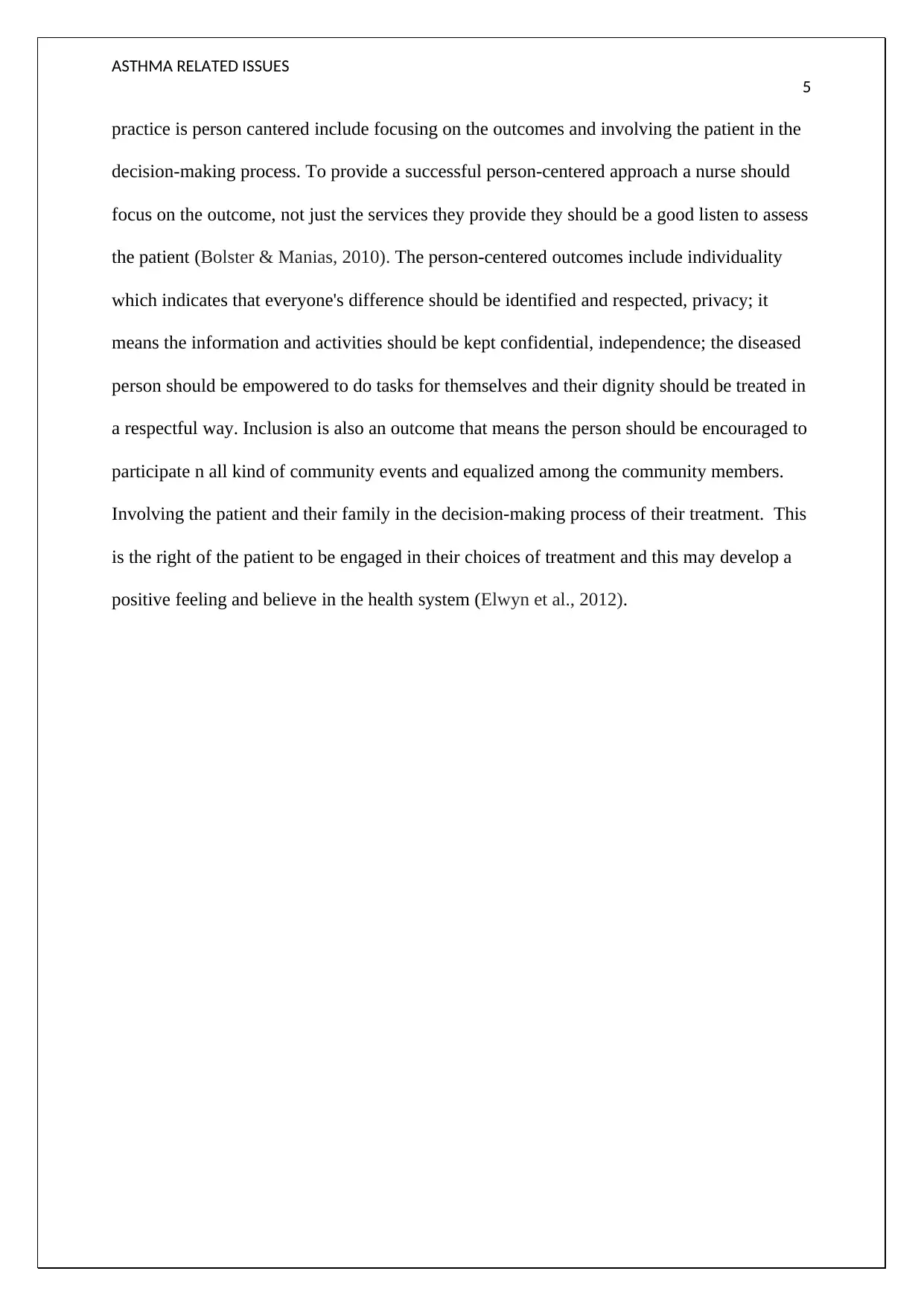
ASTHMA RELATED ISSUES
5
practice is person cantered include focusing on the outcomes and involving the patient in the
decision-making process. To provide a successful person-centered approach a nurse should
focus on the outcome, not just the services they provide they should be a good listen to assess
the patient (Bolster & Manias, 2010). The person-centered outcomes include individuality
which indicates that everyone's difference should be identified and respected, privacy; it
means the information and activities should be kept confidential, independence; the diseased
person should be empowered to do tasks for themselves and their dignity should be treated in
a respectful way. Inclusion is also an outcome that means the person should be encouraged to
participate n all kind of community events and equalized among the community members.
Involving the patient and their family in the decision-making process of their treatment. This
is the right of the patient to be engaged in their choices of treatment and this may develop a
positive feeling and believe in the health system (Elwyn et al., 2012).
5
practice is person cantered include focusing on the outcomes and involving the patient in the
decision-making process. To provide a successful person-centered approach a nurse should
focus on the outcome, not just the services they provide they should be a good listen to assess
the patient (Bolster & Manias, 2010). The person-centered outcomes include individuality
which indicates that everyone's difference should be identified and respected, privacy; it
means the information and activities should be kept confidential, independence; the diseased
person should be empowered to do tasks for themselves and their dignity should be treated in
a respectful way. Inclusion is also an outcome that means the person should be encouraged to
participate n all kind of community events and equalized among the community members.
Involving the patient and their family in the decision-making process of their treatment. This
is the right of the patient to be engaged in their choices of treatment and this may develop a
positive feeling and believe in the health system (Elwyn et al., 2012).
⊘ This is a preview!⊘
Do you want full access?
Subscribe today to unlock all pages.

Trusted by 1+ million students worldwide

ASTHMA RELATED ISSUES
6
References
Bass, P. (2018). 8 reasons to see a pulmonologist if you have asthma. Retrieved from:
https://www.verywellhealth.com/would-my-care-benefit-from-a-pulmonologist-
200635
Bolster, D., & Manias, E. (2010). Person-centered interactions between nurses and patients
during medication activities in an acute hospital setting: qualitative observation and
interview study. International journal of nursing studies, 47(2), 154-165.
Carson, K. V., Chandratilleke, M. G., Picot, J., Brinn, M. P., Esterman, A. J., & Smith, B. J.
(2013). Physical training for asthma. Cochrane Database of Systematic Reviews, (9).
Dale, C., Prieto-Merino, D., Kuper, H., Adamson, J., Bowling, A., Ebrahim, S., & Casas, J.
P. (2012). Modeling the association of disability according to the WHO International
Classification of Functioning, Disability, and Health (ICF) with mortality in the
British Women's Heart and Health Study. Journal of Epidemiol Community Health,
66(2), 170-5.
Di Marco, F., Santus, P., & Centanni, S. (2011). Anxiety and depression in asthma. Current
opinion in pulmonary medicine, 17(1), 39-44.
Elwyn, G., Frosch, D., Thomson, R., Joseph-Williams, N., Lloyd, A., Kinnersley, P., &
Edwards, A. (2012). Shared decision making: a model for clinical practice. Journal of
general internal medicine, 27(10), 1361-1367.
HÄKKINEN, A., Arkela-Kautiainen, M., Sokka, T., Hannonen, P., & Kautiainen, H. (2009).
Self-report functioning according to the ICF model in elderly patients with
rheumatoid arthritis and in population controls using the multidimensional health
assessment questionnaire. The Journal of rheumatology, 36(2), 246-253.
6
References
Bass, P. (2018). 8 reasons to see a pulmonologist if you have asthma. Retrieved from:
https://www.verywellhealth.com/would-my-care-benefit-from-a-pulmonologist-
200635
Bolster, D., & Manias, E. (2010). Person-centered interactions between nurses and patients
during medication activities in an acute hospital setting: qualitative observation and
interview study. International journal of nursing studies, 47(2), 154-165.
Carson, K. V., Chandratilleke, M. G., Picot, J., Brinn, M. P., Esterman, A. J., & Smith, B. J.
(2013). Physical training for asthma. Cochrane Database of Systematic Reviews, (9).
Dale, C., Prieto-Merino, D., Kuper, H., Adamson, J., Bowling, A., Ebrahim, S., & Casas, J.
P. (2012). Modeling the association of disability according to the WHO International
Classification of Functioning, Disability, and Health (ICF) with mortality in the
British Women's Heart and Health Study. Journal of Epidemiol Community Health,
66(2), 170-5.
Di Marco, F., Santus, P., & Centanni, S. (2011). Anxiety and depression in asthma. Current
opinion in pulmonary medicine, 17(1), 39-44.
Elwyn, G., Frosch, D., Thomson, R., Joseph-Williams, N., Lloyd, A., Kinnersley, P., &
Edwards, A. (2012). Shared decision making: a model for clinical practice. Journal of
general internal medicine, 27(10), 1361-1367.
HÄKKINEN, A., Arkela-Kautiainen, M., Sokka, T., Hannonen, P., & Kautiainen, H. (2009).
Self-report functioning according to the ICF model in elderly patients with
rheumatoid arthritis and in population controls using the multidimensional health
assessment questionnaire. The Journal of rheumatology, 36(2), 246-253.
Paraphrase This Document
Need a fresh take? Get an instant paraphrase of this document with our AI Paraphraser
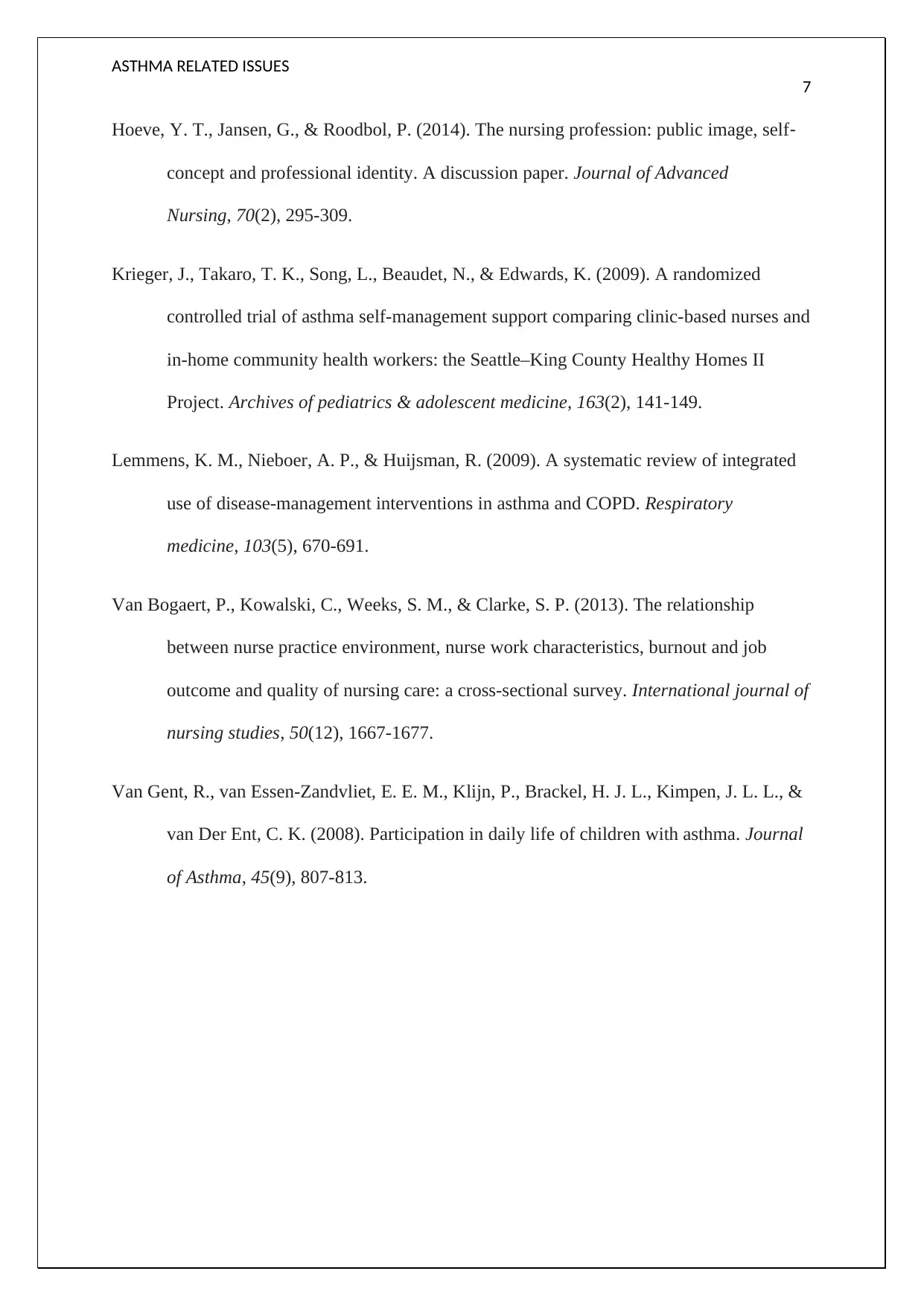
ASTHMA RELATED ISSUES
7
Hoeve, Y. T., Jansen, G., & Roodbol, P. (2014). The nursing profession: public image, self‐
concept and professional identity. A discussion paper. Journal of Advanced
Nursing, 70(2), 295-309.
Krieger, J., Takaro, T. K., Song, L., Beaudet, N., & Edwards, K. (2009). A randomized
controlled trial of asthma self-management support comparing clinic-based nurses and
in-home community health workers: the Seattle–King County Healthy Homes II
Project. Archives of pediatrics & adolescent medicine, 163(2), 141-149.
Lemmens, K. M., Nieboer, A. P., & Huijsman, R. (2009). A systematic review of integrated
use of disease-management interventions in asthma and COPD. Respiratory
medicine, 103(5), 670-691.
Van Bogaert, P., Kowalski, C., Weeks, S. M., & Clarke, S. P. (2013). The relationship
between nurse practice environment, nurse work characteristics, burnout and job
outcome and quality of nursing care: a cross-sectional survey. International journal of
nursing studies, 50(12), 1667-1677.
Van Gent, R., van Essen-Zandvliet, E. E. M., Klijn, P., Brackel, H. J. L., Kimpen, J. L. L., &
van Der Ent, C. K. (2008). Participation in daily life of children with asthma. Journal
of Asthma, 45(9), 807-813.
7
Hoeve, Y. T., Jansen, G., & Roodbol, P. (2014). The nursing profession: public image, self‐
concept and professional identity. A discussion paper. Journal of Advanced
Nursing, 70(2), 295-309.
Krieger, J., Takaro, T. K., Song, L., Beaudet, N., & Edwards, K. (2009). A randomized
controlled trial of asthma self-management support comparing clinic-based nurses and
in-home community health workers: the Seattle–King County Healthy Homes II
Project. Archives of pediatrics & adolescent medicine, 163(2), 141-149.
Lemmens, K. M., Nieboer, A. P., & Huijsman, R. (2009). A systematic review of integrated
use of disease-management interventions in asthma and COPD. Respiratory
medicine, 103(5), 670-691.
Van Bogaert, P., Kowalski, C., Weeks, S. M., & Clarke, S. P. (2013). The relationship
between nurse practice environment, nurse work characteristics, burnout and job
outcome and quality of nursing care: a cross-sectional survey. International journal of
nursing studies, 50(12), 1667-1677.
Van Gent, R., van Essen-Zandvliet, E. E. M., Klijn, P., Brackel, H. J. L., Kimpen, J. L. L., &
van Der Ent, C. K. (2008). Participation in daily life of children with asthma. Journal
of Asthma, 45(9), 807-813.
1 out of 8
Related Documents
Your All-in-One AI-Powered Toolkit for Academic Success.
+13062052269
info@desklib.com
Available 24*7 on WhatsApp / Email
![[object Object]](/_next/static/media/star-bottom.7253800d.svg)
Unlock your academic potential
Copyright © 2020–2025 A2Z Services. All Rights Reserved. Developed and managed by ZUCOL.


